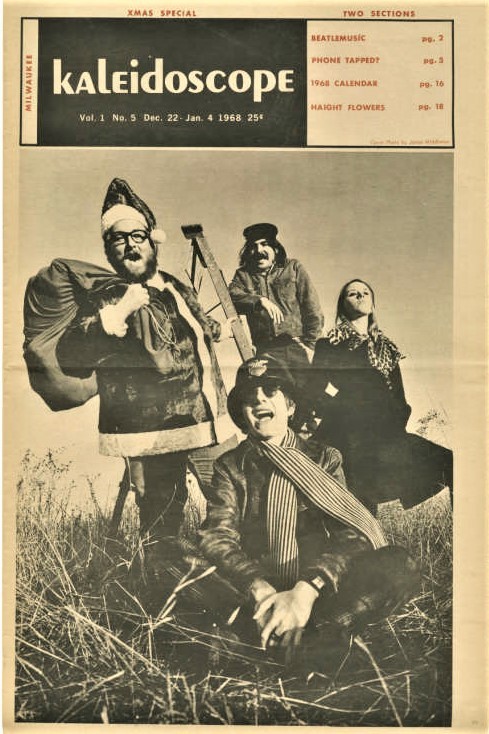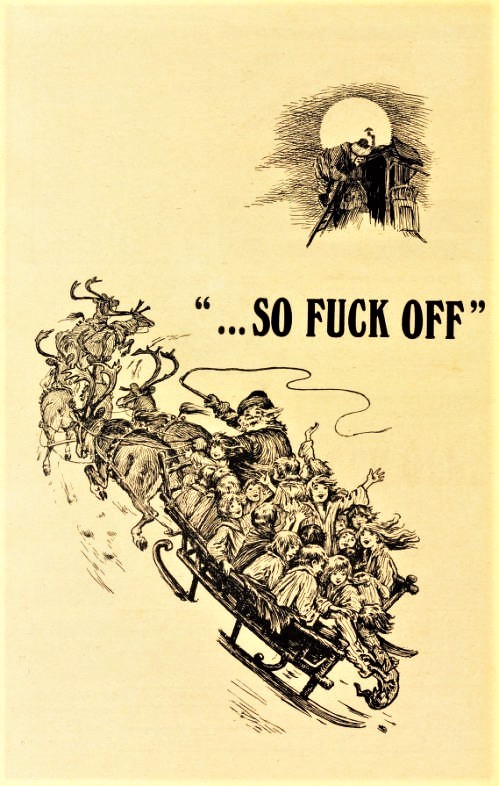#Kois vs Wisconsin
Explore tagged Tumblr posts
Photo








Boxing Day 2022
Today is Boxing Day in much of the British Commonwealth. It is usually customary for us to do a pugilistic post on this day, but since the library is closed today and we do not have access to our physical collections, we are turning instead to our digitized collection of Milwaukee’s ultra-radical underground newspaper of the late 1960s/ealry 1970s, Kaleidoscope, for their irreverant take on this holiday season.
Kaleidoscope was published in Milwaukee from October 6, 1967 to November 11, 1971. The newspaper was so radical and irreverant that its editor John Kois was convicted of obscenity. The case was appealed all the way to the Supreme Court, which ruled in Kois’s favor, although by that time the newspaper was already out of business. In Kois v. Wisconsin, Justice William O. Douglas wrote that “the vague umbrella of obscenity laws was used in an attempt to run a radical newspaper out of business . . . . If obscenity laws continue in this uneven and uncertain enforcement, then the vehicle has been found for the suppression of any unpopular tract.”
The newspaper is still considered so radical, however, that we felt compelled to offer this disclaimer to the digital collection: “Please be advised that this digital version of Kaleidoscope may contain images, language, and themes that may be offensive to some viewers. The University of Wisconsin-Milwaukee Libraries does not endorse the content of these items. However, they present an aspect of the cultural record which we deem worthy of preserving and presenting.”
So, for its rather pugilistic stance on most every issue of its day, we offer these pages from Kaleidoscope for Boxing Day 2022 (yes, yes, we know it’s not that kind of boxing!) You may review the full digitized collection of Kaleidoscope here, or you can come to UWM Special Collections to review the original newspaper for yourself.
View other posts from Kaleidoscope.
View posts from Boxing Days past.
Happy Boxing Day!
#Boxing Day#Kaleidoscope#underground newspapers#radical newspapers#John Kois#Kois vs Wisconsin#digital collections#winter holidays#pugilism
26 notes
·
View notes
Text
Drawing porn of child characters from comics or cartoons is NOT ILLEGAL in the United States (only obscenity is illegal) - Also if you’re going to copy/paste laws - actually read them
Someone asked me to weigh in on this post Before I could respond, I was blocked (I’m not sure how since OP deactivated, maybe someone who has me blocked has reblogged it? In any case, if you want to reblog the correct information you can reblog this post or add your own correction to that post).
OP correctly cited the applicable law, but it appears they did not actually read it or do not comprehend it.
(a)In General.—Any person who, in a circumstance described in subsection (d), knowingly produces, distributes, receives, or possesses with intent to distribute, a visual depiction of any kind, including a drawing, cartoon, sculpture, or painting, that—
(1)
(A) depicts a minor engaging in sexually explicit conduct; and
(B) is obscene; or
(2)
(A) depicts an image that is, or appears to be, of a minor engaging in graphic bestiality, sadistic or masochistic abuse, or sexual intercourse, including genital-genital, oral-genital, anal-genital, or oral-anal, whether between persons of the same or opposite sex; and
(B) lacks serious literary, artistic, political, or scientific value; or attempts or conspires to do so, shall be subject to the penalties provided in section 2252A(b)(1), including the penalties provided for cases involving a prior conviction.
(the definition of obscenity includes lacks serious literary, artistic, political or scientific value, so the law is doubly clear - in order for a work of art/fiction to be illegal it has to lack literary/artistic value).
This is in contrast to laws banning child pornography. Child Pornography is always illegal because in order to produce it a crime must be committed (a child must be sexually abused) and the market for it creates a demand which provides economic incentive to abuse children/sell children. That is why even receipt or possession of child pornography is a serious crime. If there is demand for child pornography (people who want it/seek it/get it) then there is incentive to create more of it and that incentive means more children will be sexually abused, raped and sold. Often child sex trafficking begins with child pornography.
(Please report Child Pornography if you see it. This can help save victims who are still being abused).
In the United States, fictional works are protected by the 1st Amendment. No one is harmed in order to produce works of fiction. The demand for fiction does not provide economic incentive to harm anyone.
However, the 1st Amendment does not protect works deemed to be obscene. Any work can be found to be obscene if it meets the definition of obscenity (or if a person charged with obscenity pleads guilty rather than defend their rights).
Fiction that features sexual depictions of minors are not considered obscene simply because they sexually depict minors. The standard of obscenity is not ‘this is gross’ or ‘I don’t like the idea of this’.
The Supreme Court held that such speech has “serious redeeming value” and noted that “the visual depiction of an idea-that of teenagers engaging in sexual activity-that is a fact of modern society and has been a theme in art and literature for centuries.”
In order for a work to be obscene it has to fall under the Miller Test. More from the Supreme Court on the subject of fiction:
“Both themes-teenage sexual activity and the sexual abuse of children-have inspired countless literary works. William Shakespeare created the most famous pair of teenage lovers, one of whom is just 13 years of age. See Romeo and Juliet, act I, sc. 2, 1. 9 ("She hath not seen the change of fourteen years"). In the drama, Shakespeare portrays the relationship as something splendid and innocent, but not juvenile. The work has inspired no less than 40 motion pictures, some of which suggest that the teenagers consummated their relationship. E. g., Romeo and Juliet (B. Luhrmann director, 1996). Shakespeare may not have written sexually explicit scenes for the Elizabethan audience, but were modern directors to adopt a less conventional approach, that fact alone would not compel the conclusion that the work was obscene.
Contemporary movies pursue similar themes. Last year's Academy Awards featured the movie, Traffic, which was nominated for Best Picture. See Predictable and Less So, the Academy Award Contenders, N. Y. Times, Feb. 14, 2001, p. Ell. The film portrays a teenager, identified as a 16year-old, who becomes addicted to drugs. The viewer sees the degradation of her addiction, which in the end leads her to a filthy room to trade sex for drugs.
The year before, American Beauty won the Academy Award for Best Picture. See "American Beauty" Tops the Oscars, N. Y. Times, Mar. 27, 2000, p. El. In the course of the movie, a teenage girl engages in sexual relations with her teenage boyfriend, and another yields herself to the gratification of a middle-aged man. The film also contains a scene where, although the movie audience understands the act is not taking place, one character believes he is watching a teenage boy performing a sexual act on an older man.
Our society, like other cultures, has empathy and enduring fascination with the lives and destinies of the young. Art and literature express the vital interest we all have in the formative years we ourselves once knew, when wounds can be so grievous, disappointment so profound, and mistaken choices so tragic, but when moral acts and self-fulfillment are still in reach.”
Art/fiction can depict minors in sexual situation and not be obscene, if there is artistic value to the work as a whole.
“The artistic merit of a work does not depend on the presence of a single explicit scene. See Book Named "John Cleland's Memoirs of a Woman of Pleasure" v. Attorney General of Mass., 383 U. S. 413, 419 (1966) (plurality opinion) ("[T]he social value of the book can neither be weighed against nor canceled by its prurient appeal or patent offensiveness"). Under Miller, the First Amendment requires that redeeming value be judged by considering the work as a whole. Where the scene is part of the narrative, the work itself does not for this reason become obscene, even though the scene in isolation might be offensive. See Kois v. Wisconsin, 408 U. S. 229, 231 (1972) (per 249 Curiam}.”
So unless the work is obscene per the Miller test/ lacks the artistic and literary value when taken as whole, then it’s protected speech. (See Ashcroft vs Free Speech Colilition https://supreme.justia.com/cases/federal/us/535/234/#tab-opinion-1961047).
You can find other posts about laws under the tag #laws . These posts are informative and do not constitute legal advice.
(Also, if posting gross things on the internet was illegal 4chan would have been taken down a long time ago) And if anyone harasses people for asking legal questions or sharing legal information, that’s messed up. Movies, books, drawings etc that you don’t like don’t hurt people. Harassing and slandering anyone hurts people.
6 notes
·
View notes